Have troubles in starting or running your dropshipping business? Check out EPROLO Academy for professional dropshipping courses!
The quest for lucrative and accessible business models brings many entrepreneurs to the doorstep of dropshipping on Amazon. This approach, characterized by its minimal upfront investment and ease of entry, offers a compelling path for aspiring business owners. In 2026, the possibility of launching a dropshipping business on Amazon without significant financial resources is a tangible reality.
In this guide, we will explore steps on how to dropship on Amazon without money, paving the way for you to embark on this venture with minimal financial risk. Whether you’re new to e-commerce or looking to expand your existing portfolio, this guide will serve as a comprehensive resource for mastering Amazon dropshipping in a financially savvy manner. Let’s dive in!
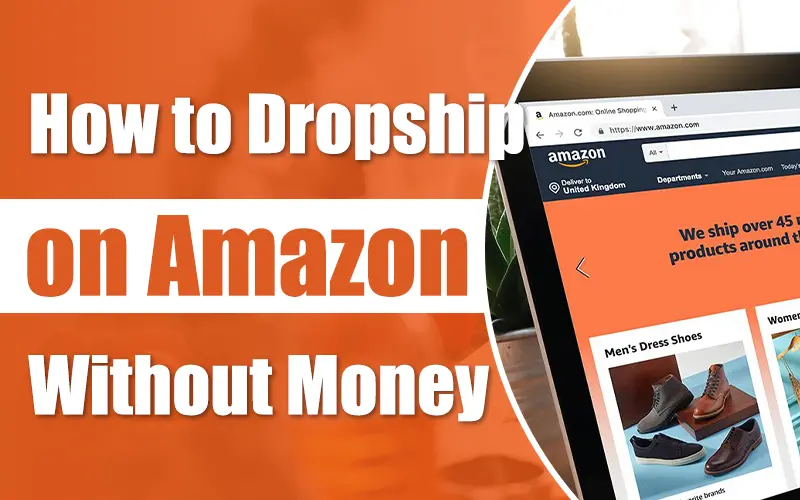
Page overview:
Is It Possible to Start Dropshipping On Amazon for Free?
7 Steps to Dropship on Amazon Without Money
1. Create an Amazon Seller Account
2. Get Approval for Product Categories
4. Work with Free Dropshipping Suppliers – EPROLO
5. Create Product Listing On Amazon
7. Manage Sales & Interact with Customers
Pros and Cons of Dropshipping On Amazon
6 Tips to Run a Successful Amazon Dropshipping Business
How Important Are Customer Reviews For Amazon Dropshipping?
Alternatives for Amazon Dropshipping
What Is Amazon Dropshipping?
Dropshipping on Amazon is a retail fulfillment method where a seller operates an online store without maintaining inventory. You purchase products from a third party—usually a dropshipping wholesaler or manufacturer— when an order is placed. The product is then shipped off to your end-customer. This model significantly reduces the upfront costs typically associated with stocking products, offering a more accessible entry point for new and aspiring Amazon dropshipper.
Amazon supports dropshipping on its platform, provided that sellers adhere to the dropshipping policies designed to maintain a high level of customer service and satisfaction. These policies include:
- Seller of Record: You must be listed as the seller of record for your products, with your company’s name and contact info on all related materials.
- Seller Identification: Ensure customers are aware that you are the seller of all products, avoiding any implication that the supplier is the seller.
- Returns Responsibility: As the seller, you are responsible for processing all returns and maintaining consistency with Amazon’s customer service standards.
- Adherence to Amazon Policies: You must comply with all of Amazon’s seller policies, ensuring high levels of performance in order delivery and customer service.
- Prohibition on Retail Arbitrage: Amazon strictly forbids purchasing from another online retailer to have them shipped to customers.
By following these guidelines, you can engage in dropshipping on Amazon in a way that’s beneficial for all parties involved: the seller(you), the customer, and Amazon itself. This adherence not only ensures compliance with Amazon’s policies but also contributes to building a sustainable and customer-focused business on one of the world’s largest e-commerce platforms.
Is It Possible to Start Dropshipping On Amazon for Free?
Starting a dropshipping business on Amazon for “free” is a notion that requires some unpacking. While Amazon dropshipping reduces the need for a large upfront investment and purchasing inventory, there are certain costs involved that you should be aware of. Let’s break down the concept of a “free” startup and delve into the Amazon dropshipping fees and related costs.
Initial Considerations
- Amazon Seller Account Fees: Amazon offers two types of seller accounts: Individual and Professional. The Individual plan doesn’t have a monthly fee, which makes it essentially free. However, it charges $0.99 per item sold, while the Professional plan charges $39.99 per month, regardless of how many items you sell.
- Dropshipping on Amazon for “Free”: When people ask if they can start dropshipping on Amazon for free, they often refer to the absence of inventory costs. Indeed, you don’t need to buy inventory upfront, which significantly lowers the barrier to entry. However, you will still need to account for the seller account fees mentioned above.
Detailed Overview of Amazon Dropshipping Fees
- Referral Fees: Regardless of your seller account type, Amazon charges a referral fee. These fees vary by category, typically ranging from 8% to 15% of the sales price (including any shipping or gift wrap charges charged by the seller).
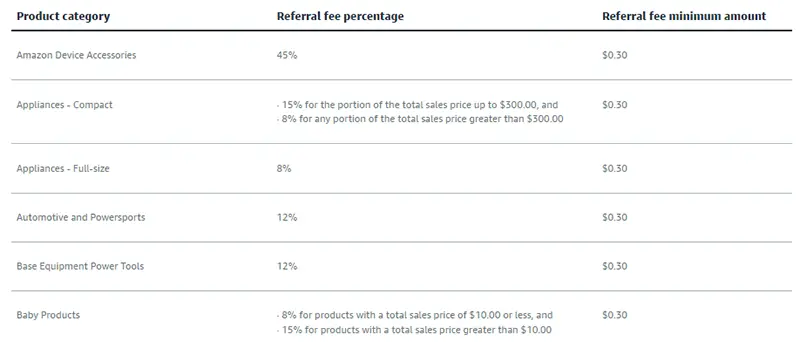
- Fulfillment Fees: If you opt for Amazon FBA (Fulfillment by Amazon) to fulfill orders made on other platforms or your dropshipping operation, you’ll incur FBA fees. The fees charged by FBA are determined by the size and weight of the product, making it crucial to consider them while devising your pricing and profitability strategy.
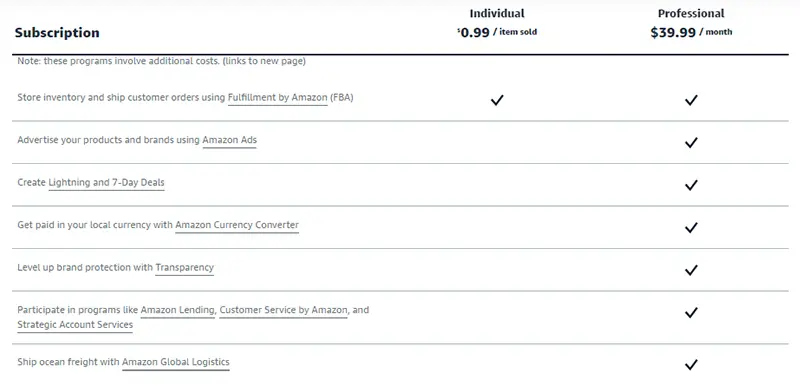
- Additional Costs: While not direct fees from Amazon, additional costs can include things like marketing, advertising on Amazon to increase visibility, purchasing UPC codes for products, and any software or tools you might use to manage your dropshipping business more efficiently.
7 Steps to Dropship on Amazon Without Money
Wondering how to dropship on Amazon without money? Here’s how to navigate through the process step by step:
1. Create an Amazon Seller Account
Creating an Amazon Seller Account is your first step. Here’s how to do it:
Step 1 – Visit Amazon Seller Central: Go to sellercentral.amazon.com and choose “Sign up” for a new account.
Step 2 – Choose Your Plan: Select between the Individual plan (no monthly fee, but $0.99 per item sold) or the Professional plan ($39.99/month, unlimited items). If you’re just starting and unsure about sales volume, start with the Individual plan.
Step 3 – Provide Your Information: You’ll need to provide your business name, legal name, and address. If you don’t have a registered business, you can use your personal information.
Step 4 – Complete the Registration: Follow the steps to enter your billing, tax information, and bank account details. Amazon will verify your information, which can take a few days.
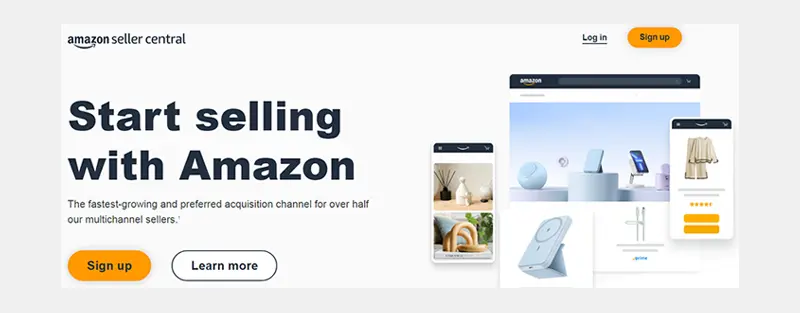
2. Get Approval for Product Categories
Some product categories require Amazon’s approval before you can start selling. Here’s how to apply:
Step 1 – Check Category Restrictions: In Seller Central, navigate to “Add a Product.” Search for the category of the product you want to sell. If it’s restricted, you’ll see an “Apply to Sell” button.
Step 2 – Prepare Necessary Documents: Depending on the category, you might need invoices from manufacturers, FDA registrations, or safety testing certificates. Gather these documents before applying.
Step 3—Apply for Approval: Click “Apply to Sell” and fill out the application form. Upload any required documents.
Here are some tips to help you navigate the approval process more smoothly:
- Understand Amazon’s Requirements: Before applying, carefully read Amazon’s guidelines for the specific category you’re interested in. Each category can have different requirements, such as invoices, certifications, or safety tests.
- Gather Invoices: Ensure you have legitimate invoices or receipts from your suppliers for the products you intend to sell. Amazon typically requires invoices dated within the last 90 days.
- Ensure Authenticity: If you’re selling branded products, you may need proof that your items are genuine. This could include authorization letters from the brand owner.
- Be Detailed in Your Application: When filling out your application, provide as much detail as possible. Clear and thorough information can expedite the approval process.
- Expect to Wait: The approval process can take time, ranging from a few days to several weeks.
- Consult Experts: If you’re struggling to get approved, consider hiring a professional with experience in Amazon’s approval process. They can offer valuable insights and assistance.
- Keep Up with Changes: Amazon’s policies and requirements can change. Regularly check for updates in the categories you’re interested in to ensure compliance.
3. Find Dropshipping Products
Consider these criteria for choosing dropshipping products:
High Demand, Low Competition: Look for products with high demand but not swamped with sellers.
Good Profit Margins: Ensure the difference between your supplier’s price and your selling price covers fees and leaves profit.
Lightweight and Easy to Ship: This reduces shipping costs and complications.
Not Easily Branded: Generic products reduce the risk of infringement issues.
Product Research Tools
- Jungle Scout
- Helium 10
- Viral Launch
- AMZScout
- Keepa
4. Work with Free Dropshipping Suppliers – EPROLO
Working with free dropshipping suppliers like EPROLO can be a game-changer. EPROLO stands out in the dropshipping industry for several reasons, making it an attractive option for new and established sellers alike. Here’s why:
Global Warehouses: EPROLO operates multiple warehouses around the world, enabling faster shipping times to various regions. This global presence ensures that your products can be stored closer to your customers, reducing wait times and improving customer satisfaction.
Large Items Shipped from the USA: For sellers focusing on larger items, EPROLO offers shipping from the USA, which can significantly reduce shipping times and costs for these bulkier products. This feature is particularly useful for sellers targeting customers in the United States.
Cost-Effectiveness: EPROLO does not charge a subscription or service fee for using its platform. This feature is particularly beneficial for new entrepreneurs who are looking to minimize startup costs.
Product Sourcing: It provides access to a vast range of products, including fashion, electronics, toys, and beauty products. This wide selection allows sellers to find almost any type of product they want to sell.
Quality Control: EPROLO maintains a standard for product quality and conducts quality checks before shipping items to customers. This service helps reduce the rate of returns and increases customer satisfaction.
Branding Services: For sellers interested in building a brand, EPROLO offers customized packaging and branding service. This feature allows for a more personalized customer experience and can help sellers distinguish themselves from competitors.
Automated Order Fulfillment: Once you integrate EPROLO with your Amazon Seller account, the platform can automate the order fulfillment process. When a customer places an order on Amazon, EPROLO automatically processes and ships the order, minimizing the need for manual intervention.
Shipping and Logistics: EPROLO offers competitive shipping times compared to other dropshipping suppliers. While shipping times can vary based on the destination, EPROLO works to ensure that products are delivered in time.

How to Use EPROLO:
1. Sign up on the EPROLO website.
2. Authorize EPROLO to your seller data.
3. Start sourcing products to list on your Amazon store.
5. Create Product Listing On Amazon
Creating a compelling product listing on Amazon is a critical step in the dropshipping process, especially when you’re starting without a significant investment. A well-optimized and attractive product listing not only draws attention but also converts visitors into customers. Here’s what a good product listing should include:
1. Compelling Product Title: Your product title should be descriptive and keyword-rich. It should include essential elements like the brand, product type, main features, and any unique selling points. The goal is to make it easy for potential customers to understand what you’re selling and for Amazon’s search algorithm to find your listing.
2. High-Quality Images: Images are the first thing customers see. Ensure you use high-resolution images that accurately represent the product. It’s advisable to use multiple images from different angles and, if applicable, in use. Images should be clear, professionally taken, and adhere to Amazon’s image guidelines.
3. Detailed Product Descriptions: A good product description provides the customer with all the information they need to make a purchase decision. Highlight the product’s benefits, features, specifications, and any other relevant details. Use bullet points for better readability, and ensure the information is accurate and straightforward.
4. Competitive Pricing: Your pricing strategy is crucial for your product’s visibility and competitiveness. Ensure your pricing is competitive without compromising too much on your profit margins. Consider using pricing tools or Amazon’s automated pricing features to keep your listings competitive.
5. Customer Reviews and Ratings: Although this is not something you can directly add to your listing at the start, encouraging satisfied customers to leave positive reviews and ratings is vital for your product’s credibility and attractiveness. Follow Amazon’s policies for soliciting feedback to ensure compliance.
6. Enhanced Brand Content (EBC) or A+ Content: If you’re a registered brand on Amazon, take advantage of Enhanced Brand Content or A+ Content. This feature allows you to add more detailed product descriptions, more images, and comparison charts. It helps in improving conversion rates by providing a better shopping experience.
7. Search Terms and Keywords: Use the backend search terms field to include relevant keywords not used in your title or bullet points. This can help your product appear in more searches without cluttering the visible listing information.
8. Fulfillment Details: Clearly mention the fulfillment method (whether it’s Fulfilled by Amazon (FBA) or fulfilled by the merchant) and shipping times. This information helps manage customer expectations regarding delivery times.
9. Product Variations: If your product comes in different sizes, colors, or other variations, list them clearly. Amazon allows you to group variations under a single parent listing, making it easier for customers to find exactly what they’re looking for.
10. Mobile Optimization: With a significant portion of Amazon shoppers using mobile devices, ensure your listings are mobile-friendly. This includes checking how your images, title, and bullet points appear on smaller screens.
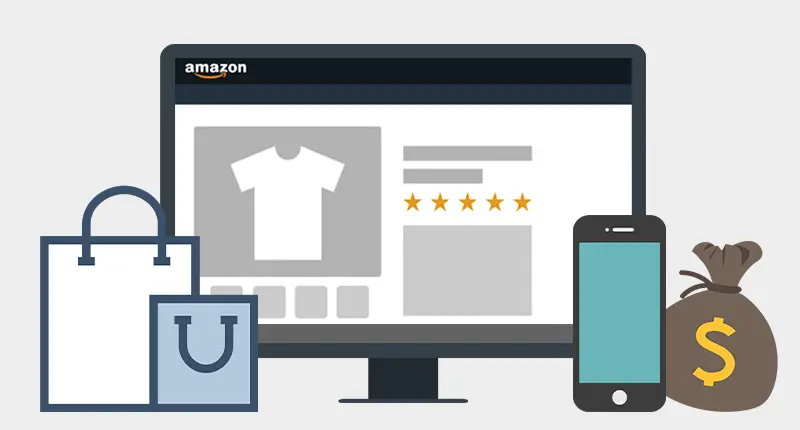
6. Market Your Products
The next crucial steps involve marketing your products effectively and managing sales while mintaining positive interactions with your customers. In the realm of dropshipping on Amazon without a substantial upfront investment, leveraging free marketing avenues is key to boosting your product’s visibility and sales. Here’s how to do it:
Social Media
Platform Selection: Choose a social media platform that targets your audience the best. Instagram, Facebook, Twitter, and Pinterest are excellent for visual products, while LinkedIn can be ideal for more professional or niche items.
Content Strategy: Develop a content strategy that includes engaging posts, stories, and videos about your products. Join relevant social media groups and enhance engagement with your audience to increase your reach.
Influencer Collaborations: Partner with micro-influencers who align with your brand. They can help you reach potential customers through authentic endorsements.
SEO (Search Engine Optimization)
Keyword Optimization: Ensure your product titles, descriptions, and backend keywords on Amazon are optimized for search engines.
Content Marketing: Create valuable content for your audiences, such as blogs, how-to guides, and tutorials. This will improve your site’s SEO and drive traffic to your Amazon listings.
Link Building: Get high-quality backlinks to your content by reaching out to bloggers and websites in your niche. This can enhance your site’s authority and search engine ranking.
Promotions
Amazon Promotions: Take advantage of Amazon’s promotional tools, such as coupons, lightning deals, and buy-one-get-one-free offers, to increase visibility and sales.
Email Marketing: Build an email list to promote new products, special offers, and content directly to interested customers. Ensure compliance with email marketing laws and Amazon’s policies.
7. Manage Sales & Interact with Customers
Once your marketing efforts start bringing in sales, managing those sales efficiently and interacting positively with your customers become crucial for long-term success.
Order Fulfillment: Although it is your dropshipping supplier who takes responsibility for order fulfillment, you still need to ensure the process is reliable and efficient. Quick and accurate shipping contributes significantly to customer satisfaction. Keep a close eye on your supplier’s inventory levels to avoid stockouts.
Customer Service: Respond to customers promptly. Add a personal touch to your interactions, such as personalized thank-you messages or follow-up emails after a purchase. This can enhance the customer experience and loyalty. Finally, handle negative reviews and feedback constructively. Offer solutions, replacements, or refunds as necessary while adhering to Amazon’s policies.
Monitor Performance: Use Amazon’s analytics tools to track your sales performance, best-selling items, and customer trends. This data can inform your inventory decisions, marketing strategies, and product development. Continuous optimization is key to staying competitive.
Pros and Cons of Dropshipping On Amazon
Dropshipping on Amazon offers a unique business model, but like any business model, it comes with its own set of advantages and challenges.
Pros of Dropshipping on Amazon
Low Startup Costs: Dropshipping has made it possible for new entrepreneurs to start selling without worrying about the costs and logistics of inventory. With dropshipping, you can sell products and outsource fulfillment, focusing on growing your business.
Wide Audience Reach: Amazon’s vast customer base provides dropshippers with immediate access to millions of potential customers, increasing the chances of making sales.
Ease of Scaling: Without the need to manage physical inventory, scaling a dropshipping business is more straightforward. You can add new products without significant logistical concerns.
Reduced Risk: Since you’re not purchasing inventory upfront, there’s less risk involved if products do not sell as expected.
Cons of Dropshipping on Amazon
High Competition: The low barrier to entry means you’ll likely face intense competition, including from other dropshippers selling similar products.
Lower Profit Margins: Amazon’s fees, combined with competition, can lower your profit margins, especially when compared to other e-commerce models or platforms.
Limited Control Over Supply Chain: Relying on third-party suppliers means you have less control over inventory levels, shipping times, and product quality, which can impact customer satisfaction.
Amazon’s Strict Policies: Amazon has stringent rules for dropshippers, including ensuring prompt shipping and handling customer service issues, which can be challenging if your supplier is unreliable.
6 Tips to Run a Successful Amazon Dropshipping Business
Running a successful Amazon dropshipping business boils down to optimizing your operations, ensuring customer satisfaction, and maintaining a competitive edge. Here are some expert tips to keep in mind:
Choose the Right Supplier: Establish direct communication with potential suppliers. Consider suppliers with experience in dropshipping and those who offer integration capabilities for easier order management. Conducting periodic reviews of your supplier’s performance can help maintain high standards.
Optimize Your Listings: Beyond using high-quality images and detailed product descriptions, conduct keyword research to identify terms your customers are using. Incorporate these keywords naturally into your titles, bullet points, and descriptions. Regularly updating your listings based on customer feedback and changing trends can also keep your offerings fresh and relevant.
Leverage Amazon’s Tools: Take full advantage of Amazon’s Sponsored Products to increase the visibility of your listings. Utilize Amazon Brand Registry if eligible, which provides access to Enhanced Brand Content, allowing for a richer product story through images and text. Keep an eye on Amazon’s analytics to understand sales trends and customer preferences.
Provide Exceptional Customer Service: Set up an efficient system for monitoring and responding to customer queries and feedback. Consider automating part of your customer service process to ensure quick responses, but also personalize communication when necessary. A satisfied customer is more likely to return and recommend your products to others.
Monitor Your Competitors: Use tools to track your competitors’ pricing, product launches, and promotional strategies. This information can help you make informed decisions about your pricing, product selection, and marketing efforts. Stay agile, ready to adapt your strategies in response to market changes and competitor actions.
Stay Compliant with Amazon’s Policies: Regularly review and adhere to Amazon’s dropshipping policy, which mandates that you must be the seller of record for your products, identify yourself as the seller on all packing slips, and remove any third-party packing slips, invoices, or external identifiers before shipping the product.
How Important Are Customer Reviews For Amazon Dropshipping?
Customer reviews are essential for several reasons:
Trust and Credibility: Positive reviews can significantly enhance your brand’s credibility, encouraging new customers to purchase from you.
Influence Purchase Decisions: Many customers read reviews before making a purchase decision. Positive reviews can help them decide if they want to buy from you.
Visibility and SEO: Products with higher ratings and more reviews tend to rank better in Amazon’s search results.
Feedback Loop: Reviews provide valuable feedback on your products and customer service, offering insights that can help you improve your business and product offerings.
In summary, fostering positive customer reviews is essential for building trust, enhancing visibility, and driving sales in an Amazon dropshipping business. It can contribute significantly to your business’s success.
Alternatives for Amazon Dropshipping
Now that you know how to start dropshipping for free on Amazon, let’s take a look at some alternatives. Exploring alternatives to dropshipping on Amazon can uncover new opportunities for growth and diversification in your e-commerce strategy. Here are three viable options, each with its unique set of advantages and considerations.
1.Fulfillment by Amazon (FBA)
Fulfillment by Amazon (FBA) is a service designed to help sellers automate their shipping and logistics by utilizing Amazon’s extensive network of fulfillment centers. Products are stored in Amazon’s warehouses until sold. Once an order is placed, Amazon not only packs and ships these products but also provides customer service for them.
FBA vs. Dropshipping
Inventory Management: FBA requires you to purchase and send inventory to Amazon’s fulfillment centers, whereas dropshipping involves ordering products from the supplier only after a sale is made.
Control Over Shipping: FBA gives you access to Amazon Prime’s fast shipping options, potentially increasing your product’s appeal to a broader audience. In dropshipping, shipping times can be longer and less predictable.
Fees: FBA involves various fees, including storage and fulfillment fees, which can be higher than the costs associated with dropshipping. However, these fees pay for the convenience of hands-off fulfillment and customer service.
Customer Service: With FBA, Amazon handles customer service and returns for FBA products, potentially offering a smoother experience for both sellers and customers compared to managing these aspects yourself in dropshipping.
2. Shopify with Third-Party Logistics (3PL)
With Shopify, you can create your very own online store. When combined with Third-Party Logistics (3PL) providers, it offers a powerful alternative to Amazon dropshipping. This setup involves using a 3PL company to store your inventory and fulfill orders while Shopify provides the storefront and e-commerce tools.
Brand Control: Unlike Amazon, selling on Shopify gives you full control over your branding and customer experience.
Customization and Integration: Shopify offers extensive customization options through themes and apps, allowing for a tailored shopping experience and integration with various 3PL providers.
Fees: Shopify charges monthly subscription fees and transaction fees, but you have more control over shipping costs and pricing strategies.
Marketing Responsibility: You’re responsible for driving traffic to your store, requiring a solid strategy for SEO, social media, and other marketing efforts.
3. eBay Dropshipping
eBay Dropshipping is another alternative where sellers list products on eBay without holding inventory, similar to Amazon dropshipping. When a product sells, the seller purchases it from a third party and has it shipped directly to the customer.
Marketplace Diversity: eBay offers access to a different customer base and allows for the sale of a wider variety of products, including used items, collectibles, and unique finds.
Selling Fees: eBay’s fee structure is different from Amazon’s, often consisting of listing fees and a percentage of the sale price.
Flexibility: eBay provides flexibility in auction and fixed-price listings, offering different strategies for selling products.
Customer Interaction: Sellers may find more opportunities for direct customer interaction on eBay, which can be leveraged to build rapport and encourage repeat business.
Start Dropshipping on Amazon without Money: Conclusion
Concluding our comprehensive guide on how to dropship on Amazon without money in 2026, it’s evident that with the right strategies, commitment, and focus on customer satisfaction, entering the e-commerce realm is more accessible than ever. This journey requires navigating through choosing the right products, optimizing product listings, leveraging free marketing channels, and providing exceptional customer service—all while adhering to Amazon’s policies.
The key takeaway is that success in dropshipping doesn’t hinge on a significant upfront investment but rather on the ingenuity, diligence, and adaptability of the entrepreneur. It’s a path filled with potential and opportunity, offering a gateway to the e-commerce world without the traditional barriers to entry.
How to Start Dropshipping for Free on Amazon: FAQs
Do you need money to start dropshipping on Amazon?
Technically, you can start dropshipping on Amazon with minimal upfront investment, but some costs cannot be entirely avoided. While you don’t need to purchase inventory upfront, you will need to cover Amazon’s seller account fees, which vary depending on the plan you choose. Additionally, any marketing efforts outside of Amazon’s platform, like social media advertising or creating a website, will incur extra costs. However, these expenses are significantly lower compared to traditional retail business models.
How much does it cost to dropship on Amazon?
The cost to dropship on Amazon can vary widely depending on the type of seller account you choose, marketing and advertising expenses, and the costs associated with your dropshipping suppliers. Individual account costs $0.99 per item sold, and Professional account costs $39.99 per month. Other potential costs include Amazon’s referral fees, which are a percentage of each sale and vary by category, and any additional costs for enhanced advertising or premium account features.
Is Amazon-to-eBay dropshipping allowed?
Amazon-to-eBay dropshipping, where sellers list products on eBay at a higher price and purchase the item from Amazon when a sale is made, is generally frowned upon by both platforms. eBay specifically discourages sellers from using this model as it can lead to a poor buyer experience due to potentially longer shipping times and issues with returns. Furthermore, using Amazon as a dropship supplier can violate Amazon’s policies if not done correctly, potentially leading to account suspension. It’s crucial to review and adhere to each platform’s policies before engaging in such a practice.
Is it worth it to dropship on Amazon?
Dropshipping on Amazon can be worth it if approached correctly. However, it comes with challenges such as high competition, lower profit margins, and strict adherence to Amazon’s policies. If you’re willing to put in the effort to understand and navigate the complexities of the Amazon marketplace, dropshipping can be a lucrative e-commerce business model.







